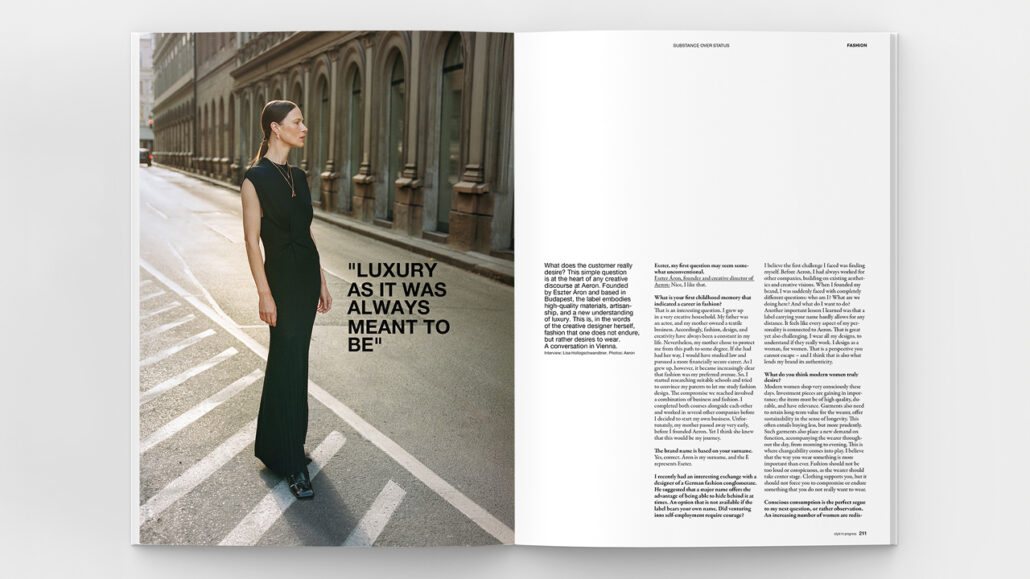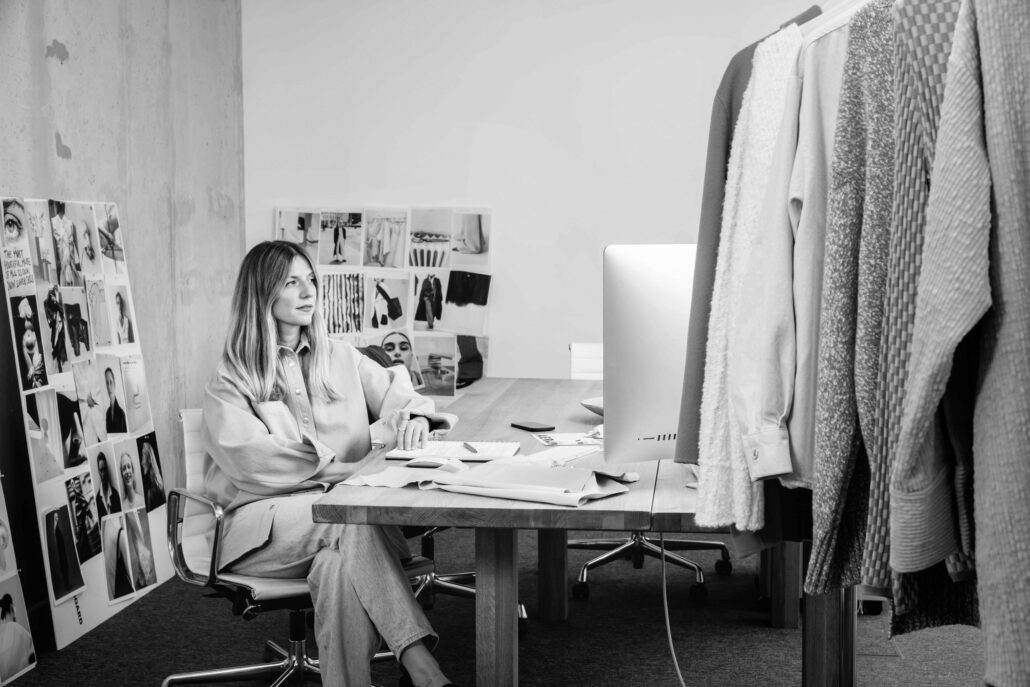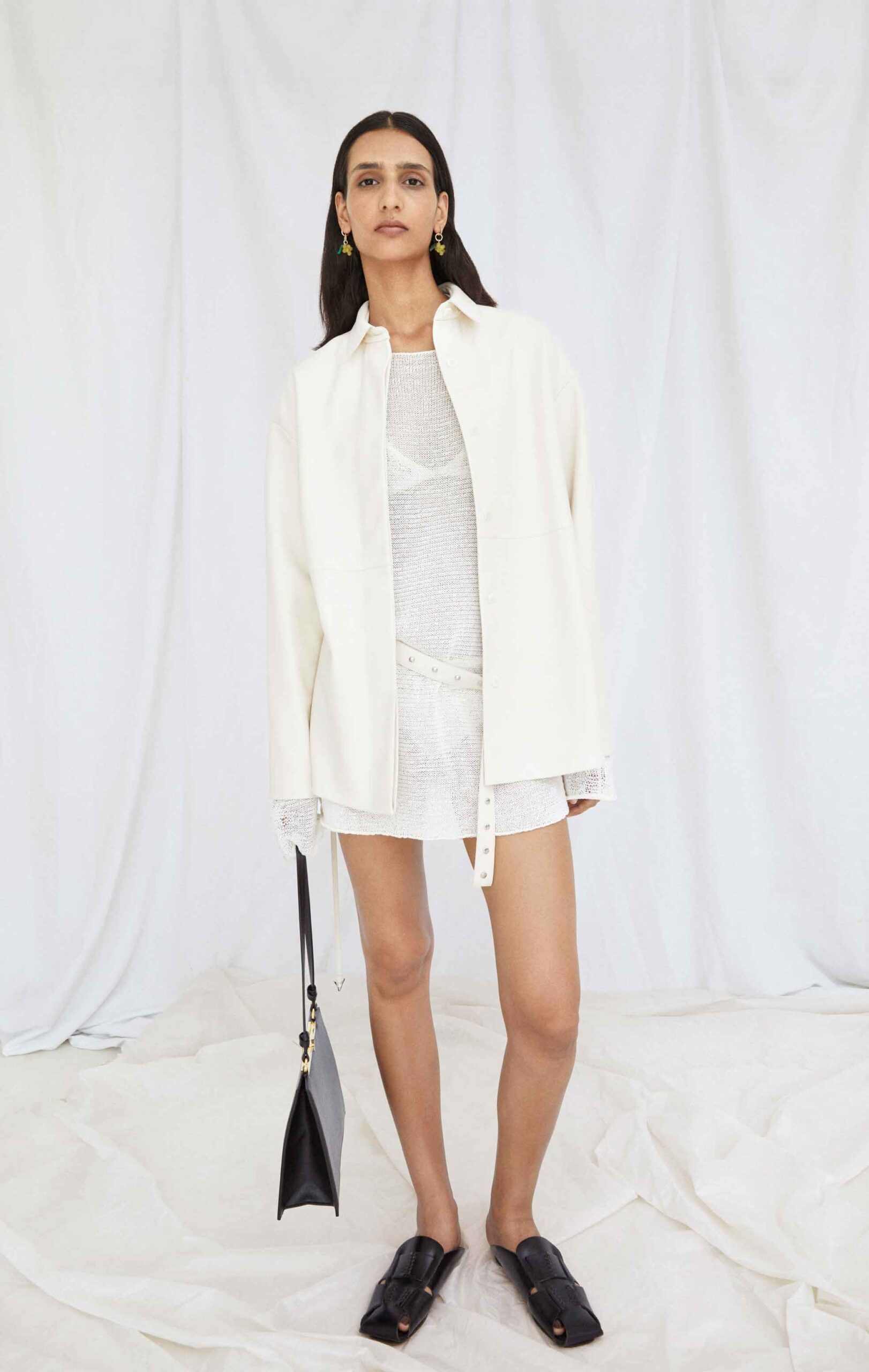Aeron
“Luxury as It Was Always Meant to Be”

What does the customer really desire? This simple question is at the heart of any creative discourse at Aeron. Founded by Eszter Áron and based in Budapest, the label embodies high-quality materials, craftsmanship, and a new understanding of luxury. This is, in the words of the creative designer herself, fashion that one does not endure but rather desires to wear. A conversation in Vienna.
Interview: Lisa Hollogschwandtner. Photos: Aeron
Eszter, my first question may seem somewhat unconventional.
Eszter Áron, founder and creative director of Aeron: Nice, I like that.
What is your first childhood memory that indicated that a career in fashion?
That is an interesting question. I grew up in a very creative household. My father was an actor, and my mother owned a textile business. Accordingly, fashion, design, and creativity have always been a constant in my life. Nevertheless, my mother chose to protect me from this path to some degree. If she had had her way, I would have studied law and pursued a more financially secure career. As I grew up, however, it became increasingly clear that fashion was my preferred avenue. So, I started researching suitable schools and tried to convince my parents to let me study fashion design. The compromise we reached involved a combination of business and fashion. I completed both courses alongside each other and worked in several other companies before I decided to start my own business. Unfortunately, my mother passed away very early, before I founded Aeron. Yet I think she knew that this would be my journey.
The brand name is based on your surname.
Yes, correct. Áron is my surname, and the E represents Eszter.
I recently had an interesting exchange with a designer of a German fashion conglomerate. He suggested that a major name offers the advantage of being able to hide behind it at times. An option that is not available if the label bears your own name. Did venturing into self-employment require courage?
I believe the first challenge I faced was finding myself. Before Aeron, I had always worked for other companies, building on existing aesthetics and creative visions. When I founded my brand, I was suddenly faced with completely different questions: Who am I? What are we doing here? And what do I want to do?
Another important lesson I learned was that a label carrying your name hardly allows for any distance. It feels like every aspect of my personality is connected to Aeron. That is great yet also challenging. I wear all my designs, to understand if they really work. I design as a woman for women. That is a perspective you cannot escape – and I think that is also what lends my brand its authenticity.
What do you think modern women truly desire?
Modern women shop very consciously these days. Investment pieces are gaining in importance; the items must be of high quality, durable, and have relevance. Garments also need to retain long-term value for the wearer, offer sustainability in the sense of longevity. This often entails buying less, but more prudently. Such garments also place a new demand on function, accompanying the wearer throughout the day, from morning to evening. This is where changeability comes into play. I believe that the way you wear something is more important than ever. Fashion should not be too loud or conspicuous, as the wearer should take center stage. Clothing supports you, but it should not force you to compromise or endure something that you do not really want to wear.
Conscious consumption is the perfect segue to my next question, or rather observation. An increasing number of women are redistributing their personal consumption budget. In addition to fashion, aspects such as self-care, beauty, travel, and interior design are gaining importance. Are you observing this trend too?
Yes, that is something we sense very keenly at Aeron – and I honestly believe it is a positive development. Clothing is important, but there are so many other important things in life. The logical consequence for us is to produce less and in a more purposeful manner. A woman does not need a hundred pieces in her closet, she needs the right ones. I feel the solution to the debate concerning overproduction is to ask ourselves a very simple question: What does the customer really desire? Sustainability is extremely complex. There is no perfect approach. Yet I believe that as long as our pieces find their rightful place in our customers‘ closets and are worn for a long time due to their quality and aesthetics, we are on the right track.
Does that translate into more staples, less statements?
I love balance. To me, 50/50 is a healthy ratio. A statement piece styled with something simple. I also find the interplay between masculine and feminine exciting.
You mentioned playing with contrasts. How realistic is a gender-neutral future of fashion in your opinion?
I am very receptive to the topic. In fact, we are currently planning a capsule collection along these lines. Yet as a small brand, this is naturally also a question of resources. Every new segment you want to tap into constitutes an additional investment. However, some of our pieces are already unisex. I believe that the future lies not so much in a specific definition, but in a new degree of openness. By that I mean: It is less about consciously designing in a gender-neutral style but rather about a new self-conception of fashion that allows everyone to wear what they want.
You describe Aeron’s brand philosophy as: “Luxury as it was always meant to be.” What does luxury mean to you personally?
For me, everything starts with the fabric. Thanks to my mother, I was introduced to many different materials at an early age. The aesthetics come next, followed by the finishing. Every piece in our collection is designed and manufactured in our studio in Budapest. To me, genuine craftsmanship is at the heart of luxury. Many of the big heritage brands have abandoned these principles. Of course, they will continue to exist, but I personally find it much more exciting to discover luxury through smaller brands – featuring real stories, via personal contact. It feels like discovering a hidden treasure when you come across a brand that not everyone is aware of yet.



